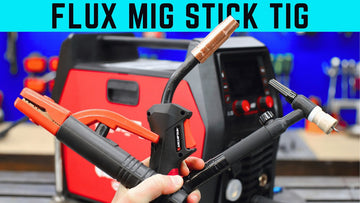Fundamentals of the 4 Most Popular Welding Methods: Stick, MIG, Flux Core, and Lift TIG
Apr 30, 2025

In this article, we provide a high-level overview of the four most popular welding methods currently available: Stick Welding, Flux Core MIG, MIG, and TIG. All demonstrations are performed using the new Arccaptain MIG205 Pro, which is regarded as the best multi-process welder on the market.

I. Stick Weld:
MMA, or Manual Metal Arc welding—commonly known as stick welding—involves using a consumable electrode made of the same material as the metal being joined. The electrode is placed into an electrode holder, and a ground clamp completes the circuit, creating an arc that melts the metal.
Stick welding has both advantages and disadvantages. The consumable rod gets used up, and its flux coating protects the weld while molten, forming a slag that can be satisfying to peel off but requires cleanup afterward.
The process mainly involves setting the amperage, which controls the heat. Keep in mind that once the machine is on, the electrode is live, so contact with the workpiece will create an arc. If you have trouble striking the arc, try increasing the amperage. Peeling off the slag after welding is a rewarding part of the process.
II. Flux Core MIG
Flux Core Welding (FCAW) is a process that utilizes a tubular wire electrode filled with flux. Often considered a variation of MIG welding, it is also known as Gasless MIG because it doesn't require external shielding gas. The flux in the core generates shielding gases and slag, protecting the weld from atmospheric contamination. While FCAW is similar to MIG welding, it differs by using a tubular wire electrode instead of a solid wire. Due to its high deposition rates and versatility in all positions, FCAW is widely used in construction, shipbuilding, and pipeline welding.
The Arccaptain MIG205 Pro is a versatile multi-process welder, allowing users to easily switch to Flux Core Welding mode for various applications.
III. MIG
Metal Inert Gas (MIG) welding is an arc welding process that employs a continuous solid wire electrode, which is heated and fed into the weld pool via a welding gun. The two base materials are melted together to form a joint. The gun also supplies a shielding gas to protect the weld pool from airborne contaminants, ensuring a clean and strong weld.
If you want beautiful welds with little to no cleanup, MIG welding is the better choice compared to Flux Core Welding. To switch from Flux Core to MIG, you'll need to change the wire from flux-cored to solid wire, set up a gas tank for shielding and change polarity.
MIG welding is ideal for automotive bodywork and small sheet metal applications. By incorporating a slight oscillating motion, it is possible to achieve attractive, clean weld patterns. However, a notable drawback is the requirement for shielding gas, which entails an initial investment that can be relatively costly.
IV. Lift Tig
Lift TIG welding is a subset of Tungsten Inert Gas (TIG) welding, distinguished by its distinctive arc initiation method. Unlike traditional TIG welding, which often uses high-frequency starting, Lift TIG requires the welder to touch the tungsten electrode to the workpiece and lift it to create the arc. This technique reduces the risk of contamination and interference, making it a preferable choice in various scenarios.
For more information, you can check the video from DIYPro:
Arccaptain MIG205 Pro:
The Arccaptain MIG205Pro is a groundbreaking multi-process welder equipped with MIG, gasless MIG, spot MIG, spool gun MIG (aluminum welding), stick welding (MMA), and lift TIG, easily adapting to various welding applications.
Arccaptain has integrated advanced arc-starting technology into the MIG205 Pro, significantly improving ignition success rates. Its new architecture ensures stable performance, better welding continuity, and enhanced weld quality.
Additionally, the MIG205 Pro features the innovative iControl function, allowing remote operation in challenging environments such as undercarriage welding and enabling users to create and recall customized welding databases for various scenarios.
